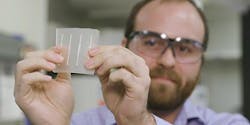Researchers One Step Closer to Mimicking Blood Brain Barrier on a Chip
The blood brain barrier (BBB) in humans consists of blood vessels and tissues that regulate the passage of chemicals and other substances going from the bloodstream into the brain. It does a good job of keeping potentially harmful molecules from crossing over and affecting the central nervous system. The downside is that if clinicians need to treat a brain problem, such as toxic chemical exposure or a tumor, it’s difficult to get therapeutic drugs across that barrier to do their jobs.
Currently scientists rely heavily on animal models to develop drugs that can make it safely past the barrier. But animals aren’t the best models for humans. Having a low-cost and accurate computer model that mimics the BBB could help in developing drugs and countermeasures to chemicals and biological agents that affect the brain.
Engineers and biologists at Lawrence Livermore National Laboratory (LLNL) recently made significant strides in modeling the BBB in 2D and 3D by combining fluidics with cell seeding. This combination also models cultures of cells around the barrier in both static and flow states, a development that would make future brain-on-a-chip devices more physiologically relevant.
LLNL’s flexible approach, researchers say, will become a valuable tool for studying the BBB, letting scientists carry out a variety of experiments such as improving drug delivery and understanding disruptions that cause brain disorders, and to easily observe and analyze changes in the brain cells without changing the device.
“Often with these organ-on-a chip devices, engineers will make a device designed only for what they’re interested in studying. Sometimes these complicated fluidic designs are made for specific purposes and you can’t really do anything beyond the intended purpose,” says LLNL engineer Monica Moya. “Our device is reconfigurable. This means you can repeat different experiments on a single device. It’s also easy to manufacture. You don’t need a clean room. it’s a simple molded design. And if we want to recover the sample and do further processing, we can.”
The new platform developed at LLNL, which fits in the palm of the hand, reproduces key BBB characteristics, including its main elements: cerebral endothelial cells, support cells, and astrocytes.
To make the device, researchers fabricated four independent channels—hollow “fibers” mimicking arteries—and sandwiched them between two silicone-based organic polymer sheets. The team seeded the fibers with endothelial cells from the human brain on the inside of the channels, introduced astrocytes (glial cells in nerve cells) on the outside, and modeled the brain’s flow of blood by continuously pumping a fluid through the device’s chambers. Ports on the outside of the device let the team sample molecules that make it across the barrier.
The researchers demonstrated their BBB device can culture cells under static or flow conditions of varying rates; the “flow” of media in the device consists of nutrients for cells such as proteins and sugars mimicking the blood. The researchers found they could culture support cells with either astrocytes and endothelium in contact with each other or separately, to better understand interactions between them. They found they could also test the device in three dimensions by embedding human-derived astrocytes in a hydrogel around the fibers to understand the effect of matrix interactions on the entire neurovascular unit. Investigators maintained a healthy population of astrocytes for nearly a month, proving it could support experiments in three-dimensional space—a clear advantage over 2D fluidic models. The device can withstand and report on stresses caused by flow, so it is a “truly comparable control” for experiments in physiological flow mechanics.
In the human body, the cells that make up our blood vessels, including the micro-vessels that make up the BBB, grow and develop under flow conditions. To isolate the effect of flow mechanics on the endothelium, you need a device that can culture these cells not only under various flow rates but also under static conditions. This device gives researchers the flexibility to successfully culture cells under various flow rates, including flow rates outside the physiological range, and directly compare those results to a static control.
Due to its unique design, Lab scientists can introduce cells and nutrients into the device and remove waste products without stopping the flow or removing the device from an incubator. After seven days, researchers observed a layer of endothelial cells had formed a connected monolayer with the tight junctions that make up the BBB. In addition to successfully recreating the BBB, researchers showed the barrier system was responsive.
Researchers characterized the barrier by analyzing its permeability to dextran, a carbohydrate made from glucose. They found transport of dextran increased in response to two stimulants: a protein that causes inflammation and a signal protein that causes blood vessels to form, just as it would in the human body. They also tested the active transport of calcein-AM. They found they could block calcein-AM from leaving the endothelial cells in the barrier with a transport inhibitor called verapamil. Perhaps most significantly, the endothelial cells also responded to the flowing fluid by aligning themselves in the direction of the flow and changing shape, suggesting the cells reorganize under flow conditions. The findings were contrary to several previously published studies that had looked at flow exposure for less than two days. Flow alignment in the LLNL chip was observed as early as three days after flow was started and persisted prominently through 14 days.
“Many studies that were claiming endothelial cells in the brain don’t line up with flow were done for much shorter times,” Moya explains. “We found it takes at least three to five days before you start to see that alignment. The evidence is pretty pronounced; it’s obvious these cells are definitely responsive to flow.”
The LLNL team said future work could focus on coupling the BBB device with the Lab’s brain-on-a-chip device, creating a much stronger, more physiologically relevant platform. Other research could look at understanding the effects of flow, timing, and geometry on cell alignment within the fibers. Tweaking the device’s design could allow for materials better suited for large-scale production, such as thermoplastics, the researchers concluded. Moya and her group also are working on bio-printing the BBB to remove the synthetic barrier in the device’s channels, so as to better mimic natural interactions between cells.

